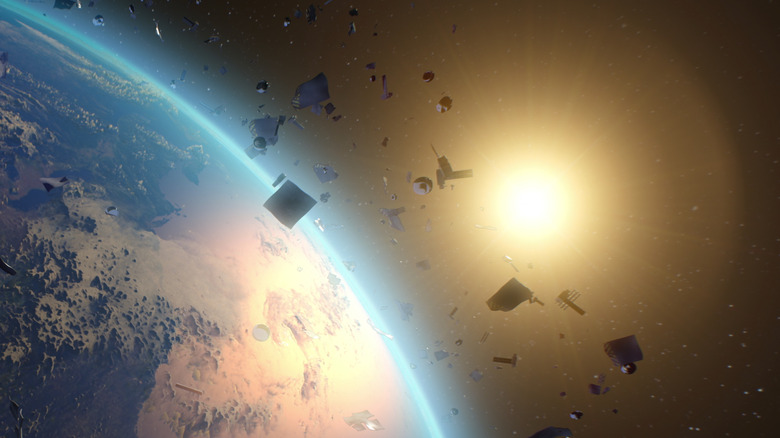The FCC Is Tired Of Space Junk
Over the past few years, calls for handling the issue of space debris have intensified significantly, going beyond the NASA labs and into the White House chambers. Researchers have repeatedly warned that as more satellites are launched into space, increasing amounts of trash are posing a hazard to the space environment and should be controlled with the utmost urgency. According to the European Space Agency's Annual Space Environment Report, more than 30,000 pieces of space junk in Earth's orbit have been documented as of 2022.
In a study published in Nature Astronomy, experts from Edinburgh University called the problem a severe risk to "professional astronomy, public stargazing, and the cultural importance of the sky, as well as the sustainability of commercial, civic, and military activity in space." In a Nature feature, Purdue University astrodynamical researcher Carolin Frueh remarked that "if we go on like this, we will reach a point of no return."
It appears that space agencies like NASA are not the only stakeholders worried sick about the problem. The U.S. Federal Communications Commission (FCC) has now proposed a new rule that would try to mitigate the space rubble issue by forcing satellite operators to get their disposal operations completed within five years of performing their first missions. Right now, operators get up to 25 years to ensure that their satellites return to Earth after concluding their jobs in the low-Earth orbit (LEO). Notably, the new rule only covers LEO satellites that float within an altitude of around 1,200 miles from the Earth's surface.
There's a tricky road ahead
As part of the proposal, the FCC seeks to quicken the disposal process for satellites that are licensed by the U.S., and even those beyond the American licensing terms if they serve the U.S. market. The agency will vote on the recommendations at a meeting scheduled for September 29. Notably, the FCC doesn't highlight any specific methods for getting rid of space litter. But so far, experts have proposed numerous solutions, such as minimizing the generation of mission-related debris during the deployment and use of spacecraft.
Hastening the orbital decay of spacecraft and rocket bodies at the expiration of their functional lives, and placing rocket bodies and spacecraft in disposal orbits are also viable solutions, according to the book "Orbital Debris: A Technical Assessment." Collision risks are not the only problem, though. Due to the time and fuel required for each maneuver, which could otherwise be utilized for the spacecraft's primary task, satellite managers are unable to steer clear of every potential collision.
However, the removal of space trash isn't a job that a single agency, or country, can handle. It needs to be a collaborative effort, with equitable participation from the biggest culprits in terms of resource and effort allocation. According to a Statista report published in September 2022, Russia contributes the lion's share of space garbage, followed by China and the United States. However, the geopolitical tensions between the three nations far outweigh the technical challenges that scientists have outlined.
